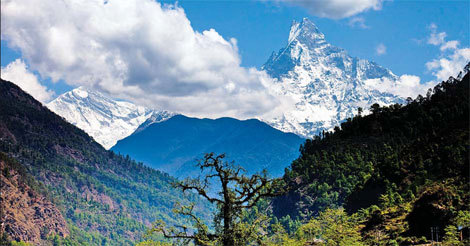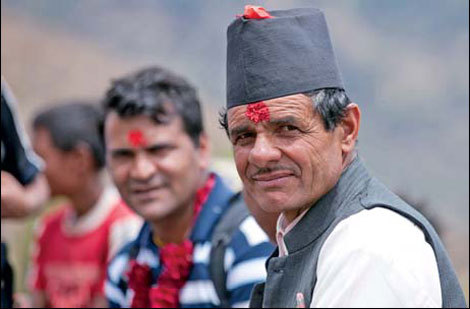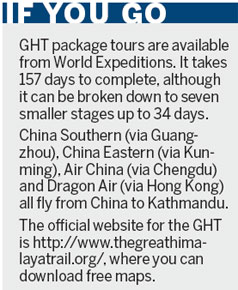An epic journey
Updated: 2011-09-08 16:00
By D J Clark (China Daily)
|
|||||||||||
 |
|
The Great Himalaya Trail passes through lush green valleys, arid high plateaus and incredible landscapes. Photos by D J Clark / for China Daily |
 |
|
Visiting some of the most remote communities along the trail. |
It won't be long before everyone knows about the Great Himalaya Trail and will want to own the bragging rights of completing it. D J Clark reports.

Asking for six months holiday may be a bit of stretch, but that is what you would need to walk the newly formed Great Himalaya Trail (GHT). If you go for the tour package it would cost you over 200,000 yuan ($31,300) but in completing it you will have walked 1,700 km, seen all 14 of Nepal's tallest peaks and have crossed passes at more than 6,000 meters.
It's a rigorous epic journey but one the Nepalese tourist bureau hopes will attract thousands of new visitors each year.
I asked Mim Hamal, tourism advisor for Dutch development organization SNV, which is working with the Nepalese government to develop the trail, how the idea came about.
"By learning from the Appalachian trail in the United States and the Inca trail in the Andes. Those trails can demonstrate very high results at local level and attract large numbers of tourists in the remote areas."
There are 16 districts in the Himalaya trail and these are the least developed, inaccessible and inhabited by poor ethnic minorities.
"Tourism is the main source of income to them as tourism brings consumers directly to their homes. They can sell their vegetables, handicrafts and potteries," Hamal says.
SNV sees the success of such a venture as enriching some of Asia's poorest communities by selling their most valuable asset, the stunning Himalayan scenery that surrounds them.
In order to make it more accessible they have divided the trail into 10 sections, all of which can be tackled one at a time, in the hope that tourists will return on multiple trips until they have completed all 10. However, the organizers are hoping the concept will go beyond Nepal.
"This is piloting in Nepal, if we can demonstrate good results and bring more tourists off the beaten track and local people benefit then certainly other countries will be interested.
"The future idea is to upscale the trail in the west to China, Pakistan and Afghanistan and in the east to India, Bhutan and Myanmar. There is great potential to expand the Himalaya trail to make it the longest trail in the world."
The full length of the trail could stretch to 4,500 km, still 500 km short of the Continental Divide Trail in the US and a quarter of the length of the Trans Canada. But its exotic location combined with the pull of the world's highest mountain range is sure to make it the most sought after.
So far more than 4,000 have climbed the world's highest mountain but only three people are known to have completed the GHT, giving exclusive bragging rights to anyone finishing it in the near future.
I only managed a few days on two sections of the trail in Annapurna and Dolpa during which time I quickly felt its steep paths on my knees.
But for those who can endure, the rewards are plentiful.

In the areas I walked I found an equal mix of mountain tranquility and the buzz of small Nepalese villages with rich colorful culture.
It's poor too, in Dolpa I was there to write a food crisis story, and contributing to the local economy gives you an additional sense of satisfaction.
On my way out at the mountain top Jhuphal airport I met retired Californian teacher Josephine Murphy who had spent a week on the trail.
"This is really down to earth. Meeting with people and the children and what can we do as part of humanity. I would like to do my share, so if there is anyone out there wanting to do this please do.
"It's an experience you will never forget," Murphy says.
It's not an average adventure holiday but as Murphy explains undoubtedly one that would stay in the memory for a long time.
Nepal has invested a lot of energy in putting in the infrastructure to cater for tourists and training the local people along the trail to provide good hospitality.
My advice would be to go sooner than later to be one of the first along the trail and experience it without the crowds.